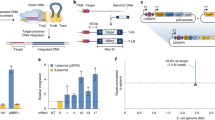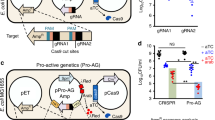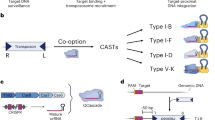Abstract
Mobile group II introns can be retargeted to insert into virtually any desired DNA target. Here we show that retargeted group II introns can be used for highly specific chromosomal gene disruption in Escherichia coli and other bacteria at frequencies of 0.1–22%. Furthermore, the introns can be used to introduce targeted chromosomal breaks, which can be repaired by transformation with a homologous DNA fragment, enabling the introduction of point mutations. Because of their wide host range, mobile group II introns should be useful for genetic engineering and functional genomics in a wide variety of bacteria.
This is a preview of subscription content, access via your institution
Access options
Subscribe to this journal
Receive 12 print issues and online access
$209.00 per year
only $17.42 per issue
Buy this article
- Purchase on Springer Link
- Instant access to full article PDF
Prices may be subject to local taxes which are calculated during checkout





Similar content being viewed by others
Accession codes
References
Lambowitz, A.M., Caprara, M.G., Zimmerly, S. & Perlman, P.S. Group I and group II ribozymes as RNPs: clues to the past and guides to the future. In The RNA world, Edn. 2. (eds Gesteland, R.F., Cech, T.R. & Atkins, J.F.) 451–484 (Cold Spring Harbor Laboratory Press, Cold Spring Harbor, NY; 1999).
Belfort, M., Derbyshire, V., Parker, M.M., Cousineau, B. & Lambowitz, A.M. Mobile introns: pathways and proteins. In Mobile DNA, Edn. 2. (eds Craig, N., Craigie, R., Gellert, M. & Lambowitz, A.M.) (ASM Press, Washington DC; 2002), in press.
Eskes, R., Yang, J., Lambowitz, A.M. & Perlman, P.S. Mobility of yeast mitochondrial group II introns: engineering a new site specificity and retrohoming via full reverse splicing. Cell 88, 865–874 (1997).
Cousineau, B. et al. Retrohoming of a bacterial group II intron: mobility via complete reverse splicing, independent of homologous DNA recombination. Cell 94, 451–462 (1998).
Eskes, R. et al. Multiple homing pathways used by yeast mitochondrial group II introns. Mol. Cell. Biol. 20, 8432–8446 (2000).
Cousineau, B., Lawrence, S., Smith, D. & Belfort, M. Retrotransposition of a bacterial group II intron. Nature 404, 1018–1021 (2000).
Saldanha, R. et al. RNA and protein catalysis in group II intron splicing and mobility reactions using purified components. Biochemistry 38, 9069–9083 (1999).
Guo, H. et al. Group II introns designed to insert into therapeutically relevant DNA target sites in human cells. Science 289, 452–457 (2000).
Guo, H., Zimmerly, S., Perlman, P.S. & Lambowitz, A.M. Group II intron endonucleases use both RNA and protein subunits for recognition of specific sequences in double-stranded DNA. EMBO J. 16, 6835–6848 (1997).
Mohr, G., Smith, D., Belfort, M. & Lambowitz, A.M. Rules for DNA target-site recognition by a lactococcal group II intron enable retargeting of the intron to specific DNA sequences. Genes Dev. 14, 559–573 (2000).
Singh, N.N. & Lambowitz, A.M. Interaction of a group II intron ribonucleoprotein endonuclease with its DNA target site investigated by DNA footprinting and modification interference. J. Mol. Biol. 309, 361–386 (2001).
Belfort, M. & Pedersen-Lane, J. Genetic system for analyzing Escherichia coli thymidylate synthase. J. Bacteriol. 160, 371–378 (1984).
Davanloo, P., Rosenberg, A.H., Dunn, J.J. & Studier, F.W. Cloning and expression of the gene for bacteriophage T7 RNA polymerase. Proc. Natl. Acad. Sci. USA 81, 2035–2039 (1984).
Jasin, M. Genetic manipulation of genomes with rare-cutting endonucleases. Trends Genet. 12, 224–228 (1996).
Puchta, H., Dujon, B. & Hohn, B. Two different but related mechanisms are used in plants for repair of genomic double-strand breaks by homologous recombination. Proc. Natl. Acad. Sci. USA 93, 5055–5060 (1996).
Donoho, G., Jasin, M. & Berg, P. Analysis of gene targeting and intrachromosomal homologous recombination stimulated by genomic double-strand breaks in mouse embryonic stem cells. Mol. Cell. Biol. 18, 4070–4078 (1998).
Posfai, G., Kolisnychenko, V., Bereczki, Z. & Blattner, F.R. Markerless gene replacement in Escherichia coli stimulated by a double-strand break in the chromosome. Nucleic Acids Res. 27, 4409–4415 (1999).
Murphy, K.C. Use of bacteriophage λ recombination functions to promote gene replacement in Escherichia coli. J. Bacteriol. 180, 2063–2071 (1998).
Zhang, Y., Buchholz, F., Muyrers, J.P.P. & Stewart, F.A. A new logic for DNA engineering using recombination in Escherichia coli. Nat. Genet. 20, 123–128 (1998).
Datsenko, K.A. & Wanner, B.L. One-step inactivation of chromosomal genes in Escherichia coli K-12 using PCR products. Proc. Natl. Acad. Sci. USA 97, 6640–6645 (2000).
Murphy, K.C., Campellone, K.G. & Poteete, A.R. PCR-mediated gene replacement in Escherichia coli. Gene 246, 321–330 (2000).
Yu, D. et al. An efficient recombination system for chromosome engineering in Escherichia coli. Proc. Natl. Acad. Sci. USA 97, 5978–5983 (2000).
Ellis, H.M., Yu, D., DiTizio, T. & Court, D.L. High efficiency mutagenesis, repair and engineering of chromosomal DNA using single-stranded oligonucleotides. Proc. Natl. Acad. Sci. USA 98, 6742–6746 (2001).
Matsuura, M. et al. A bacterial group II intron encoding reverse transcriptase, maturase and DNA endonuclease activities: biochemical demonstration of maturase activity and insertion of new genetic information within the intron. Genes Dev. 11, 2910–2924 (1997).
Payne, S.M., Niesel, D.W., Peixotto, S.S. & Lawlor, K.M. Expression of hydroxamate and phenolate siderophores by Shigella flexneri. J. Bacteriol. 155, 949–955 (1983).
Tsai, S.P., Hartin, R.J. & Ryu, J. Transformation in restriction-deficient Salmonella typhimurium LT2. J. Gen. Microbiol. 135, 2561–2567 (1989).
Hamilton, C.M., Aldea, M., Washburn, B.K., Babitzke, P. & Kushner, S.R. New method for generating deletions and gene replacements in Escherichia coli. J. Bacteriol. 171, 4617–4622 (1989).
Sambrook, J., Fritsch, E.F. & Maniatis, T. Molecular cloning: a laboratory manual, Edn. 2. (Cold Spring Harbor Laboratory Press, Cold Spring Harbor, NY; 1989).
Acknowledgements
This work was supported by NIH grant GM37949. We thank Stephanie Reeves, Shelley Payne and Rasika Harshey for Shigella and Salmonella strains and Marlene Belfort and Keith Derbyshire (Albany) for comments on the manuscript.
Author information
Authors and Affiliations
Rights and permissions
About this article
Cite this article
Karberg, M., Guo, H., Zhong, J. et al. Group II introns as controllable gene targeting vectors for genetic manipulation of bacteria. Nat Biotechnol 19, 1162–1167 (2001). https://doi.org/10.1038/nbt1201-1162
Received:
Accepted:
Issue Date:
DOI: https://doi.org/10.1038/nbt1201-1162
This article is cited by
-
Development of an efficient ClosTron system for gene disruption in Ruminiclostridium papyrosolvens
Applied Microbiology and Biotechnology (2023)
-
CRISPR RNA-guided integrases for high-efficiency, multiplexed bacterial genome engineering
Nature Biotechnology (2021)
-
Lessons from Clostridial Genetics: Toward Engineering Acetogenic Bacteria
Biotechnology and Bioprocess Engineering (2021)
-
Reconstitution of TCA cycle involving l-isoleucine dioxygenase for hydroxylation of l-isoleucine in Escherichia coli using CRISPR-Cas9
3 Biotech (2020)
-
Construction of a novel Escherichia coli expression system: relocation of lpxA from chromosome to a constitutive expression vector
Applied Microbiology and Biotechnology (2019)



